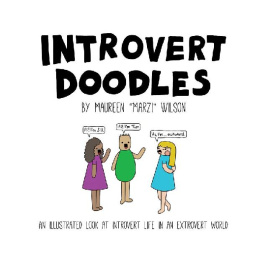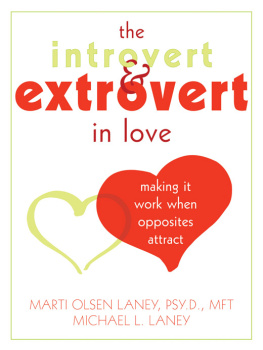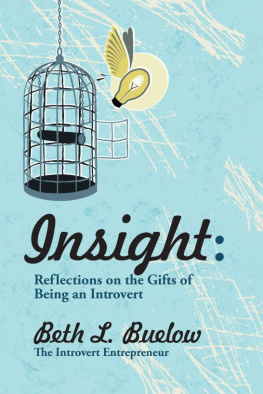If youve often felt out of place, overwhelmed by social expectations, or overloaded by the hubbub of life, then this book is for you. Its for the person whos easily overstimulated by light, noise, people. Who enjoys a lot of alone time. Who feels like they wear an extrovert mask to get through large chunks of life.
Much of this book is my own journey from miserable, cantankerous faux extrovert to happy but still delightfully cantankerous introvert. Its how I found self-acceptance and developed much greater acceptance of others, too.
This is not a book you need to read in order. Think of it as your Introvert Resource Kit full of strategies, stories, humor, inspiration, and psychological insights into the introvert life. Start wherever you like, read what draws you in, highlight, re-read, leave lying around for your extroverted loved ones to *accidentally* stumble across.
The goal of this book is to help you understand theres nothing wrong with being an introvert.
To celebrate the pleasures of the introvert life.
To laugh with you about the idiosyncrasies of our introvert tendencies.
To help you accept yourself and others so we all enjoy greater respect and happiness.
Knowing yourself is the beginning of all wisdom.
Theres a lot of confusion about what exactly an introvert is. Partly this is because there are different ways the word is used.
1. Common Definitions
In common usage, introverted is often used as a synonym for shy. But as any introvert knows, these are not the same things at all. I, for one, am rather an extreme introvert, but Im not particularly shy. (We talk more about this in How To Tell The Difference Between Introversion And Shyness.)
2. Jung
Renowned psychoanalyst Carl Jung wrote of introverts as people who lose energy during social interaction, while extroverts gain energy from being with others. According to Jung, most people are a mix of the two anyone who was purely one or the other would be in the lunatic asylum (his words, not mine!).
Although theres some evidence for Jungs energy distinction, its not quite what psychologists mean when they talk about the introversion-extroversion continuum.
3. MBTI
The hugely popular Myers-Briggs Type Indicator extends aspects of Jungs theories and classifies sixteen personality types. Most people enjoy identifying their profile and learning about the implications for their personal and work life. I an INTJ sure do.
However, the MBTI does not meet psychologists requirements for a statistically valid and psychometrically sound personality test.
4. Psychology
Psychologists conceive of introverts as being sensitive to stimulation noise, people, lights, everything. Because of this sensitivity, introverts are easily over-stimulated and become uncomfortable with too much input. This explains why many introverts avoid parties and crowds and enjoy simpler, smaller pleasures. Why they cancel plans and crave personal space. Why they register everything thats going on and feel exhausted by it all.
Extroverts, by contrast, tend to need a higher level of stimulation to feel comfortable. For them, plenty of people around and lots going on feels good. Too little stimulation can be unpleasant.
According to psychological research, the tendency toward introversion or extroversion is biologically based and appears to be relatively stable throughout life.
This is not to say that people are born one defined way and stay the same forever. We are all affected by life experiences, different environments, and countless other factors human psychology is not simple! But there does appear to be a tendency toward introversion or extroversion thats relatively fundamental to our personalities. And understanding this can help us to know ourselves better, to be kinder to ourselves and others, and to enjoy greater happiness.
Because psychologists look to evidence and research to back up their theories, and because my background is psychology, the psychological approach to introversion is the one I take in this book.
If youve just picked up this book, you may be wondering what exactly being an introvert means and how to make sense of an introvert personality in an extrovert world. Or you may be wondering what you should have for lunch, which is also a fair and at times troubling question. Either way, I have answers for you (get the burger).
We are all Individuals (Im not)
Many subjects in psychology focus on what people have in common. Perception, cognition, developmental psychology, neuropsychology, social psychology, even psychopathology they all look at whats the same about us.
But personality psychology, the rebel of the psychology world, is concerned with our individual psychological differences.
The kinds of questions personality psychologists are interested in are:
- How are people different: is there a set of dimensions on which people differ?
- How is an individual unique: can this be scientifically described?
Isnt Personality just for Bad Hair Days?
You could say your personality is made up of those individual differences that are:
- Psychological as opposed to say, cultural, biological, intellectual, age-related differences
- Enduring consistent-ish over time and situations, rather than moods or emotions that come and go
- General patterns of thinking, feeling, and behaving versus specific attitudes or habits.
In the 1930s psychologists tried to figure out how these individual differences might be structured, what the set of dimensions of individual difference might be. (If we were lipsticks, for example, they were looking for aspects like the shade, matte-versus-gloss-ness, degree of pigment, moisturizing quality.)
They began with a dictionary, and searched for all the various adjectives used to describe people. Yep, really! And it makes sense can you think of a better starting point?
They then subjected these descriptive words to a cunning statistical method called factor analysis, which allowed them to cull many overlapping descriptors down to underlying, fundamental dimensions.
Over decades it emerged that many studies by different researchers using various data, samples, and assessment methods all yielded the same five dimensions (though different researchers had given them different names). These factors showed considerable reliability and validity (i.e., were psychometrically sound) and also stayed pretty stable throughout adulthood. They were called the Big Five because the dimensions were broad and abstract, each subsuming many narrower traits within it.











